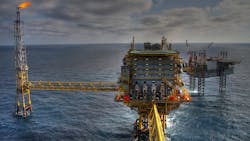Preventing and mitigating oil sheen formation associated with produced water
As oil fields mature, an increasing amount of water is produced. Oil sheen is a visual phenomenon due to the differences between the refractive index of oil and water. Sheens caused by the release of oil-in-water can be characterized by their appearance. This characterization is used to identify the extent of the sheen that has formed and can even be utilized to estimate the thickness of oil on the surface and thus the volume of oil in the area of the sheen.
In the United States, according to the National Pollutant Discharge Elimination System (NPDES) General Permit, "sheen" means a silvery or metallic sheen, gloss or increased reflectivity, visual color or iridescence on the water surface. In Canada, the National Oceanic and Atmospheric Administration (NOAA) defines oil sheens as oil layers less than 2 or 3 μm in thickness, as opposed to slicks, which are greater than 3 μm in thickness. Colorful sheens occur when the thickness of these oil layers approaches the wavelength of visible light (less than a micron).
The Bonn Agreement is understood to be the oldest regional agreement established by governments for responding to oil pollution incidents. It is a mechanism by which nine governments of the Great North Sea and its wider approaches, together with the European Union, cooperate in dealing with pollution of the North Sea by oil and other harmful substances.
Regulating oil sheen production
In general, it is understood that oil sheen formation from the discharges of produced water, or indeed from any other hydrocarbon discharge sources to the ocean, must be prevented. Oil sheen indicates an apparent oil pollution to the general public, even though the amount of oil involved in forming the oil sheen may be minimal.
When it comes to discharge of produced water offshore, many of the limits around the world were set on the assumption that if one achieves the target using the best available treatment technology, oil sheens are unlikely to be seen from such discharges.
Sheen formation associated with the discharge of produced water is a known and accepted phenomenon. For most countries around the world, there are no specific regulatory requirements relating to oil sheen formation resulting from the discharge of produced water. This is certainly the case, for example, in Australia, Canada and the North Sea.
The perception had been that if the discharge of produced water meets the oil-in-water discharge limit or performance standard set by the regulatory bodies, then oil sheen should not occur. However, oil sheen can occur regularly even if the oil content in the discharged produced water is well within the discharge limit and/or a performance standard set by the regulatory bodies.
An exception to the above is the U.S, where the operator permit holder is required to: “monitor free oil using the visual sheen test method on the surface of the receiving water. Monitoring shall be performed daily when discharging, during conditions when observation of a sheen on the surface of the receiving water is possible in the vicinity of the discharge, and when the facility is manned. If a sheen is observed in the course of required daily monitoring, or at any other time, the operator must record the sheen and assess the cause of sheen. The operator must keep records of findings and make the record available for inspector’s review. The operator must report total number of days of sheen observed during the reporting period.”
The detection of oil sheens is a way of identifying problems and issues that may have occurred with oil production and produced water discharges, to help prevent more potentially serious oil pollutions. The regulators will monitor persistent oil sheen occurrence from the discharge of produced water and may ask the operators to conduct investigations and take mitigation actions.
Occasional sheens were observed on Canada’s east coast due to offshore oil and gas production. Sheen monitoring was recommended as a means of complying with Canada Oil and Gas Drilling and Production Regulations, and Newfoundland Offshore Petroleum Drilling and Production Regulations. However, there are no specific protocols outlined in the regulations. As a result, most operators direct platform and rig personnel to watch for sheens as part of their daily activities, investigate sources if sheens are observed and report to the Canada-Newfoundland and Labrador Offshore Petroleum Board (C-NLOPB) within 24 hours of the incident. Over a 12-year observation period between 2003 to 2014, on average there were 24 reported observations of oil sheens around the three oil production platforms in the Grand Banks. Again, the observed number of sheens indicated that sheens may be a regular occurrence around platforms when oceanic conditions are favorable for formation (calm seas).
It is generally accepted that the formation of oil sheen from the discharge of produced water is predominantly related to its dispersed oil content, i.e., oil droplets. Since produced water is essentially a continuous discharge, the ocean acts as a large separator with a longer residence time than typically utilized for oil and water separation during treatment on offshore platforms. Due to buoyancy force, with oil being generally lighter than water, these oil droplets will then rise, with some reaching the ocean surface and spreading.
As soon as the oil starts to spread over the surface of the sea, it is technically classified as oil sheen. But oil sheen formation is also linked to the characteristics of the receiving water, e.g., temperature; current; wave; weather conditions such as wind and sunlight; the rate and depth of discharge; and the characteristics of the produced water such as temperature, types of oil, concentration level of both dispersed and dissolved oil and the size of oil droplets.
Taking action
While there is very little that one can do to change the ocean conditions below and above surface, actions can be taken to prevent and mitigate oil sheen formation associated with the discharge of produced water. These may include:
- Reducing the amount of water being produced and being brought to the surface.
- Increasing the amount of produced water being re-injected
- Reducing the amount of oil content in the discharged produced water.
- Optimizing the topside multiphase separation and produced water treatment processes.
- Deploying online oil-in-water monitoring tools that can detect process upset conditions and help optimize produced water treatment processes easily.
- Discharging produced water at a depth well below the ocean surface to allow oil droplets to disperse and degrade before they have had the chance to rise to the surface.
Dr. Ming Yang is a principal consultant at at TÜV SÜD National Engineering Laboratory. TÜV SÜD National Engineering Laboratory is a world-class provider of technical consultancy, research, testing and program management services. Part of the TÜV SÜD Group, the organization is also a global center of excellence for flow measurement and fluid flow systems and is the UK’s Designated Institute for Flow Measurement.
About the Author

Ming Yang
Dr. Ming Yang is a principal consultant at TÜV SÜD National Engineering Laboratory, a global center of excellence for flow measurement and fluid flow systems. A world-class provider of technical consultancy, research and development, testing, and calibration services to the oil and gas, water and energy sectors, the company is the UK’s Designated Institute for Flow and Density measurement, under contract from BEIS, and part of the UK’s National Measurement System.
